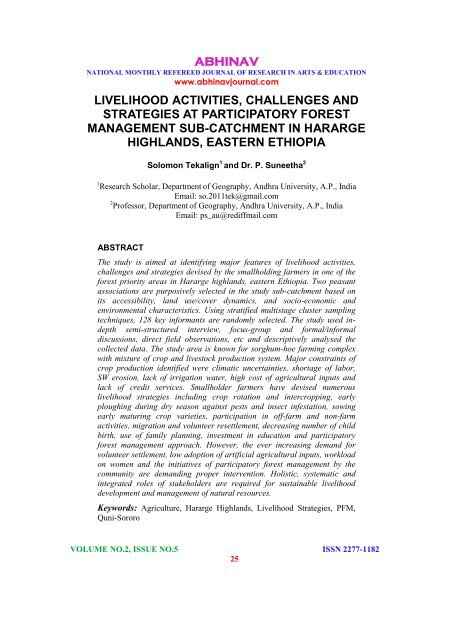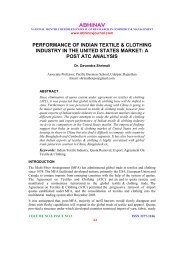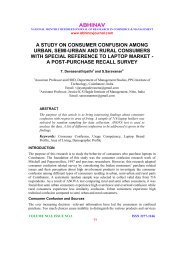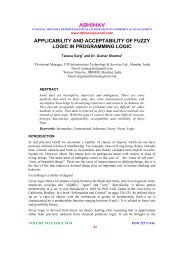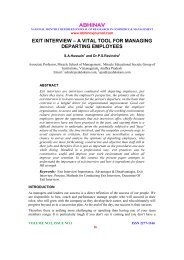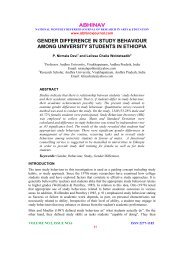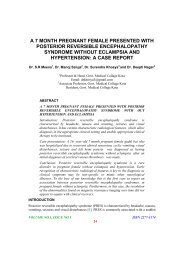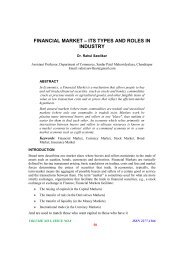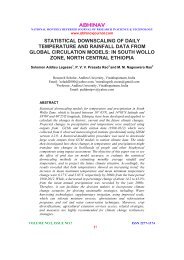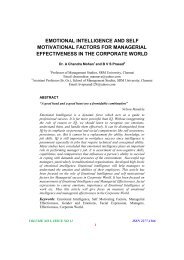Livelihood Activities, Challenges and Strategies at Participatory ...
Livelihood Activities, Challenges and Strategies at Participatory ...
Livelihood Activities, Challenges and Strategies at Participatory ...
Create successful ePaper yourself
Turn your PDF publications into a flip-book with our unique Google optimized e-Paper software.
ABHINAV<br />
NATIONAL MONTHLY REFEREED JOURNAL OF RESEARCH IN ARTS & EDUCATION<br />
www.abhinavjournal.com<br />
LIVELIHOOD ACTIVITIES, CHALLENGES AND<br />
STRATEGIES AT PARTICIPATORY FOREST<br />
MANAGEMENT SUB-CATCHMENT IN HARARGE<br />
HIGHLANDS, EASTERN ETHIOPIA<br />
Solomon Tekalign 1 <strong>and</strong> Dr. P. Suneetha 2<br />
1 Research Scholar, Department of Geography, Andhra University, A.P., India<br />
Email: so.2011tek@gmail.com<br />
2 Professor, Department of Geography, Andhra University, A.P., India<br />
Email: ps_au@rediffmail.com<br />
ABSTRACT<br />
The study is aimed <strong>at</strong> identifying major fe<strong>at</strong>ures of livelihood activities,<br />
challenges <strong>and</strong> str<strong>at</strong>egies devised by the smallholding farmers in one of the<br />
forest priority areas in Hararge highl<strong>and</strong>s, eastern Ethiopia. Two peasant<br />
associ<strong>at</strong>ions are purposively selected in the study sub-c<strong>at</strong>chment based on<br />
its accessibility, l<strong>and</strong> use/cover dynamics, <strong>and</strong> socio-economic <strong>and</strong><br />
environmental characteristics. Using str<strong>at</strong>ified multistage cluster sampling<br />
techniques, 128 key informants are r<strong>and</strong>omly selected. The study used indepth<br />
semi-structured interview, focus-group <strong>and</strong> formal/informal<br />
discussions, direct field observ<strong>at</strong>ions, etc <strong>and</strong> descriptively analysed the<br />
collected d<strong>at</strong>a. The study area is known for sorghum-hoe farming complex<br />
with mixture of crop <strong>and</strong> livestock production system. Major constraints of<br />
crop production identified were clim<strong>at</strong>ic uncertainties, shortage of labor,<br />
SW erosion, lack of irrig<strong>at</strong>ion w<strong>at</strong>er, high cost of agricultural inputs <strong>and</strong><br />
lack of credit services. Smallholder farmers have devised numerous<br />
livelihood str<strong>at</strong>egies including crop rot<strong>at</strong>ion <strong>and</strong> intercropping, early<br />
ploughing during dry season against pests <strong>and</strong> insect infest<strong>at</strong>ion, sowing<br />
early m<strong>at</strong>uring crop varieties, particip<strong>at</strong>ion in off-farm <strong>and</strong> non-farm<br />
activities, migr<strong>at</strong>ion <strong>and</strong> volunteer resettlement, decreasing number of child<br />
birth, use of family planning, investment in educ<strong>at</strong>ion <strong>and</strong> particip<strong>at</strong>ory<br />
forest management approach. However, the ever increasing dem<strong>and</strong> for<br />
volunteer settlement, low adoption of artificial agricultural inputs, workload<br />
on women <strong>and</strong> the initi<strong>at</strong>ives of particip<strong>at</strong>ory forest management by the<br />
community are dem<strong>and</strong>ing proper intervention. Holistic, system<strong>at</strong>ic <strong>and</strong><br />
integr<strong>at</strong>ed roles of stakeholders are required for sustainable livelihood<br />
development <strong>and</strong> management of n<strong>at</strong>ural resources.<br />
Keywords: Agriculture, Hararge Highl<strong>and</strong>s, <strong>Livelihood</strong> <strong>Str<strong>at</strong>egies</strong>, PFM,<br />
Quni-Sororo<br />
VOLUME NO.2, ISSUE NO.5 ISSN 2277-1182<br />
25
ABHINAV<br />
NATIONAL MONTHLY REFEREED JOURNAL OF RESEARCH IN ARTS & EDUCATION<br />
www.abhinavjournal.com<br />
INTRODUCTION<br />
Developing countries are directly dependent on environmental resources for their life <strong>and</strong><br />
livelihood. Ethiopia Highl<strong>and</strong>s cover about 44% of territory, more than 80% of human<br />
popul<strong>at</strong>ion, 86% of employment <strong>and</strong> 56% of total agricultural output (Ayalneh 2002). These<br />
highl<strong>and</strong>s are known for their inherent soil fertility <strong>and</strong> sufficient rainfall, highest<br />
agricultural potentiality in Africa as well as acceler<strong>at</strong>ed l<strong>and</strong> degrad<strong>at</strong>ion (Shiferaw et al,<br />
1997 cited in Ayalneh 2002). The Hararge highl<strong>and</strong>s are among those highl<strong>and</strong>s where<br />
cultiv<strong>at</strong>ion of crops occurs in areas over 80% of slope gradient <strong>and</strong> with only 10cm of soil<br />
depth (Mohammed et al, 2005). With long history of human settlement in the area, resultant<br />
intensity of acceler<strong>at</strong>ed soil <strong>and</strong> w<strong>at</strong>er loss from these highl<strong>and</strong>s made smallholding farmers<br />
<strong>at</strong> stake to sustain life <strong>and</strong> livelihood.<br />
The rel<strong>at</strong>ionship between dynamics in livelihood <strong>and</strong> st<strong>at</strong>us of environment varies within a<br />
country, across agro-ecological zones <strong>and</strong> even across households (Hunter 2000 cited in<br />
Tesfaye 2003). <strong>Livelihood</strong> str<strong>at</strong>egies have potential for effective maintenance of food<br />
security <strong>and</strong> sustainable NRM <strong>at</strong> household level, which may include agricultural<br />
extensific<strong>at</strong>ion/intensific<strong>at</strong>ion, change in demographic decision in favor of minimizing<br />
number of children against the so-called ‘rigid’ mental outlook of dem<strong>and</strong>ing for more<br />
children by rural community (Tesfaye 2003). Mountain communities also opted for outmigr<strong>at</strong>ion<br />
to reduce their dependence of on n<strong>at</strong>ural resources <strong>and</strong> to make important<br />
connections through financial <strong>and</strong> social remittances leading towards development of<br />
mountain areas. The current survey is to disclose crop production activities, major challenges<br />
<strong>and</strong> livelihood str<strong>at</strong>egies in one of the sub-c<strong>at</strong>chments of Jelo-Muktar forest priority areas<br />
(FPAs) of Hararge Highl<strong>and</strong>s, Eastern Ethiopia.<br />
DATA METHODOLOGY<br />
Description of the Study Area: Quni-Sororo sub-w<strong>at</strong>ershed is situ<strong>at</strong>ed within Jelo-Muktar<br />
FPA, <strong>at</strong> 8 0 55’N-9 0 05’N l<strong>at</strong>itude <strong>and</strong> 40 0 50’E-40 0 51’E longitude, about 342kms southeast of<br />
Addis Ababa. Its altitude ranges from 1900 to over 3310masl, having subtropical clim<strong>at</strong>ic<br />
condition with mean annual temper<strong>at</strong>ure of 10 0 C <strong>and</strong> mean rainfall of 1220mm. Its length of<br />
growing period ranges from 210-270days (MOA/FAO/UNDP 1983). The crystalline<br />
basement rocks form the geological form<strong>at</strong>ion overlain by Mesozoic <strong>and</strong> Cenozoic tertiary<br />
volcanic rocks to mantle the surface of most parts of the study area (Mohr 1971 in<br />
Mohammed 2003). Limestone <strong>and</strong> s<strong>and</strong>stone were also deposited upon the Precambrian<br />
basement rocks (Eyelachew 1999). It is part of the Chercher highl<strong>and</strong>s in Hararge with<br />
extensive mountain range separ<strong>at</strong>ing the Rift system from the Eastern pl<strong>at</strong>eau <strong>and</strong> lowl<strong>and</strong>s,<br />
having numerous micro-c<strong>at</strong>chments with diversified bio-physical <strong>and</strong> socio-economic<br />
environments (Eyelachew 1999; Murphy 1968). The l<strong>and</strong>form fe<strong>at</strong>ure of this sub-w<strong>at</strong>ershed<br />
is almost similar to Jelo micro-c<strong>at</strong>chment positioned on its rear side <strong>and</strong> also suited to the<br />
classific<strong>at</strong>ion of toposequences: summit, shoulder, back slope, foot slope <strong>and</strong> toe slope th<strong>at</strong><br />
do not necessarily follow sequential arrangements in descending slope position & form<br />
complex l<strong>and</strong>form associ<strong>at</strong>ions (Park et al, 2001 cited in Mohammed et al, 2005; Fig. 1).<br />
VOLUME NO.2, ISSUE NO.5 ISSN 2277-1182<br />
26
ABHINAV<br />
NATIONAL MONTHLY REFEREED JOURNAL OF RESEARCH IN ARTS & EDUCATION<br />
www.abhinavjournal.com<br />
Source: Mohammed et al, 2005<br />
Fig.1.Topographic profile <strong>at</strong> north-south cross section of the west aspect of Jelo microc<strong>at</strong>chment<br />
The micro level variability in environmental factors has resulted in sp<strong>at</strong>ial vari<strong>at</strong>ion of soil<br />
types. Based on geologic, clim<strong>at</strong>ic, topographic, biotic <strong>and</strong> p<strong>at</strong>tern of l<strong>and</strong> use/cover (LUC)<br />
dynamics, there are vari<strong>at</strong>ions in soil types as one ascends from toe slope into the shoulder<br />
<strong>and</strong> within each of these segments of the toposequences as they are unevenly distributed <strong>and</strong><br />
situ<strong>at</strong>ed throughout the highl<strong>and</strong>s. Leptosols, Cambisols, Vertisols, Phaeozems, Regosols,<br />
Fluvisols <strong>and</strong> Gleysols are the major soils in the area (Table 1). Anthropogenic processes due<br />
to shifting cultiv<strong>at</strong>ion <strong>and</strong> forest clearing has led to continuous removal of soil m<strong>at</strong>erials th<strong>at</strong><br />
strongly affected the micro-clim<strong>at</strong>e <strong>and</strong> soil development of the area (Eyelachew 1999).<br />
The study area is dissected by streams due to their erosive processes for prolonged period of<br />
time. The sub-w<strong>at</strong>ershed is within Wabi-shebele <strong>and</strong> Rift Valley drainage systems, drained<br />
by Chiro Qela <strong>and</strong> Jelo perennial streams towards the Rift system while perennial streams<br />
like Welenso <strong>and</strong> Ula Quni <strong>and</strong> seasonal streams like Rukele Arba Feno <strong>and</strong> Dingete<br />
draining towards Wabi Shebelle drainage system (EMA 1999).<br />
Table 1. Rel<strong>at</strong>ive Position of Major Soils Groups in the Jelo C<strong>at</strong>chment<br />
Major soil Rel<strong>at</strong>ive position Slope (%) c. altitude (masl) LULC<br />
Vertisols<br />
Toe slopes/valley<br />
Most<br />
1-8 1800-2350<br />
bottoms<br />
cultiv<strong>at</strong>ed<br />
Cambisols<br />
Gently & strongly<br />
Largely<br />
2-15 1825- 2200<br />
slope forms<br />
cultiv<strong>at</strong>ed<br />
Regosols<br />
Foot slopes <strong>and</strong><br />
Largely<br />
1-20 1845-2300<br />
terrace positions<br />
cultiv<strong>at</strong>ed<br />
Leptosols<br />
Steep <strong>and</strong> convex<br />
Veget<strong>at</strong>ed/<br />
4-100,c. >30 Varied, c. >2200<br />
slope forms<br />
degraded<br />
Fluvisols<br />
Along stream<br />
Most<br />
1-5 1800-2075<br />
channels<br />
cultiv<strong>at</strong>ed<br />
Phaeozems<br />
Gentle to very<br />
N<strong>at</strong>ural<br />
2-45 2300-2900<br />
steep slope forms<br />
veget<strong>at</strong>ion<br />
Source: Extracted from Mohammed (2003)<br />
VOLUME NO.2, ISSUE NO.5 ISSN 2277-1182<br />
27
ABHINAV<br />
NATIONAL MONTHLY REFEREED JOURNAL OF RESEARCH IN ARTS & EDUCATION<br />
www.abhinavjournal.com<br />
D<strong>at</strong>e <strong>and</strong> Methods: Purposive sampling was employed in the selection of the study peasant<br />
associ<strong>at</strong>ions (Quni Sagariya <strong>and</strong> Sororo) based on their accessibility, LUC dynamics, <strong>and</strong><br />
socio-economic <strong>and</strong> environmental characteristics. In-depth semi-structured interviews,<br />
focus-group discussions (FGDs), direct field observ<strong>at</strong>ions, etc were also important sources of<br />
the primary d<strong>at</strong>a after having str<strong>at</strong>ified multistage cluster sampling techniques to identify 128<br />
sample households (SHHs). The collected d<strong>at</strong>a are analyzed using descriptive techniques.<br />
Secondary d<strong>at</strong>a from st<strong>at</strong>istical reports, published/unpublished documents <strong>and</strong> archives from<br />
different institutions are used as secondary d<strong>at</strong>a sources in the study occurred from<br />
September 2011 to June 2012.<br />
RESULTS AND DISCUSSION<br />
Crop Production <strong>Activities</strong>: Ethiopian highl<strong>and</strong>s are centers of diversity of numerous<br />
globally important crops (Samberg et al, 2010). The sorghum/hoe complex is mainly known<br />
agricultural system in the Hararge Highl<strong>and</strong>s (Westpal 1975). The major food crops<br />
cultiv<strong>at</strong>ed within this system is sorghum (Sorghum bicolor L.) mixed with maize (Zea mays,<br />
L.), <strong>and</strong>/or haricot bean (Phaseolus vulgaris) while barley (Hordeum vulgare) is cultiv<strong>at</strong>ed in<br />
rel<strong>at</strong>ively cooler high altitudes of the micro-c<strong>at</strong>chment. Pot<strong>at</strong>o (Solanum tuberosum) <strong>and</strong><br />
sweet pot<strong>at</strong>o (Ipomoea arabica, L.) are also cultiv<strong>at</strong>ed to supplement cereals <strong>and</strong> onion as<br />
cash crop (Mohammed et al, 2005; Tesfaye 2003; Westphal 1975).<br />
About 2/3 rd of respondents hold cropl<strong>and</strong> less than 0.5ha <strong>and</strong> about 30.3% of them have 0.5<br />
to 1.0ha of l<strong>and</strong>. Deliber<strong>at</strong>e decision of selection of crops cultiv<strong>at</strong>ed by smallholder farmers<br />
is based on fitness of crops to their elev<strong>at</strong>ion, soil type <strong>and</strong> specific agro-ecological zone as<br />
well as high productivity (Samberg et al, 2010). In the study area, nearly 3/4 th of SHHs<br />
cultiv<strong>at</strong>ed from 2 to 4 types of crops. In Ethiopia in general smallholder farmers manage<br />
numerous small plots of l<strong>and</strong> with considerable vari<strong>at</strong>ion in soil type, fertility st<strong>at</strong>us, slope<br />
gradient <strong>and</strong> distance from home, use of soil fertility management <strong>and</strong> access to irrig<strong>at</strong>ion,<br />
etc (Chilo & Hassan 2008). Farmers have different plot numbers: about 98.4% own plot 1,<br />
21% th<strong>at</strong> of plot 2 <strong>and</strong> only 15.6% hold plot 3. Throughout these three plots, largest share of<br />
SHHs cultiv<strong>at</strong>ed on Biyyo Guracha (locally equivalent to black soils) (Fig.2).<br />
Note: Plot 1= on plains <strong>and</strong> valley bottoms, Plot 2= on gentle slopes <strong>and</strong> Plot 3= on<br />
moder<strong>at</strong>e to steep slopes upon FPAs.<br />
Source: Own survey, March 2012.<br />
Fig.2. Soil Types <strong>and</strong> Plots Owned by SHHs<br />
VOLUME NO.2, ISSUE NO.5 ISSN 2277-1182<br />
28
ABHINAV<br />
NATIONAL MONTHLY REFEREED JOURNAL OF RESEARCH IN ARTS & EDUCATION<br />
www.abhinavjournal.com<br />
With an increase in the number of plot holding, there is a decrease in the number of<br />
smallholding farmers due to numerous demographic, environmental, socio-economic,<br />
institutional <strong>and</strong> political factors. Occurrence of intensive <strong>and</strong> continuous crop production<br />
over moder<strong>at</strong>e to steep sloped <strong>and</strong> marginal forest areas have acceler<strong>at</strong>ed soil <strong>and</strong> w<strong>at</strong>er<br />
erosion, <strong>and</strong> degraded forest resources (Tesfaye 2003). Despite this fact, farmers in these<br />
areas have aspects of traditional knowledge <strong>and</strong> wisdom regarding terracing <strong>and</strong> soil bunding<br />
along steep slope where shallow soil depth prevail (Mesfine 1998). Likewise, >50% of SHHs<br />
used terracing/soil bunding as SWC methods while contour ridges <strong>and</strong> micro-basins/ponds<br />
for w<strong>at</strong>er harvesting are employed by about 16.4% <strong>and</strong> 15.6% of SHHS, respectively (Fig.3).<br />
Source: Own Survey, March 2012.<br />
Fig.3. Soil <strong>and</strong> W<strong>at</strong>er Conserv<strong>at</strong>ion (SWC) Methods Used by SHHs<br />
Source: Own survey, March 2012.<br />
Fig.4. Percentage Distribution of Agricultural Inputs Users <strong>and</strong> non-users<br />
Capital-deficient/or labor based/agricultural intensific<strong>at</strong>ion is common in the area including<br />
crop succession or rot<strong>at</strong>ion, intercropping cash with food crops <strong>and</strong> ab<strong>and</strong>onment of<br />
traditional fallowing systems (Tesfaye 2003). Among the SHHs who were interviewed,<br />
about 62.5% used animal dung (locally called dike) <strong>and</strong> only 13.3% used UREA/DAP as<br />
agricultural inputs on their agricultural l<strong>and</strong>s (Fig.4). About 1/3 rd <strong>and</strong> half of them used crop<br />
rot<strong>at</strong>ion <strong>and</strong> intercropping per se or in combin<strong>at</strong>ion as SFM methods for their farming plots<br />
(Fig.5). There is applic<strong>at</strong>ion of animal dung on farm plots without which soil productivity is<br />
almost nil. The study area is situ<strong>at</strong>ed in the upper highl<strong>and</strong>s, where adoption of traditional<br />
SFM practices is more likely than otherwise (Chilo & Hassan 2008). The use of such<br />
VOLUME NO.2, ISSUE NO.5 ISSN 2277-1182<br />
29
ABHINAV<br />
NATIONAL MONTHLY REFEREED JOURNAL OF RESEARCH IN ARTS & EDUCATION<br />
www.abhinavjournal.com<br />
methods might have affected the perception of respondents whereby about 56% <strong>and</strong> 28%<br />
mentioned the st<strong>at</strong>us of soil erosion as moder<strong>at</strong>e <strong>and</strong> low, respectively (Fig. 6).<br />
Source: Own survey, March 2012.<br />
Fig.5. Soil Fertility Management (SFM) Methods<br />
Source: Own survey, May 2012.<br />
Fig.6. Farmers’ Perceptions on St<strong>at</strong>us of Soil Erosion <strong>and</strong> Soil Fertility<br />
Crop production activities include l<strong>and</strong> prepar<strong>at</strong>ion, ploughing, irrig<strong>at</strong>ion, sowing/planting,<br />
weeding, applic<strong>at</strong>ion of fertilizers <strong>and</strong> pesticides, harvesting, threshing, transporting, storing,<br />
feeding/tre<strong>at</strong>ing, milking, marketing of agricultural products, etc (Mahlet 2005; CSA 2004).<br />
Labor alloc<strong>at</strong>ions for farming activities are obtained from family, hired/kulli, <strong>and</strong> guzaa<br />
(mutual/reciprocal labor group system equivalent to debo in other parts of Ethiopia) <strong>and</strong><br />
maqanajo (shared of oxen <strong>and</strong> human) labor. The lion share of family labor of women aged<br />
10 <strong>and</strong> over was not particip<strong>at</strong>ed in ploughing, sowing, weeding <strong>and</strong> harvest while those of<br />
men particip<strong>at</strong>ed in milking <strong>and</strong> marketing of agricultural outputs. Men aged 10 <strong>and</strong> over<br />
spent much higher full-time than those of women in ploughing, sowing, weeding, harvesting<br />
<strong>and</strong> feeding <strong>and</strong> tre<strong>at</strong>ing. Whereas, women spent much of their full-time higher than men in<br />
milking <strong>and</strong> marketing of agricultural out puts (Fig. 7).<br />
Ox-less farmers either exchange labor for oxen or make use of family labor. Hired labor<br />
(kulli) also migr<strong>at</strong>es out of Quni-Sororo to neighboring districts like Boke <strong>and</strong> Homecho by<br />
leaving their family. Guzaa is common for almost all members of the community especially<br />
during high labor dem<strong>and</strong>ing activities: ploughing, sowing, weeding, harvesting <strong>and</strong><br />
VOLUME NO.2, ISSUE NO.5 ISSN 2277-1182<br />
30
ABHINAV<br />
NATIONAL MONTHLY REFEREED JOURNAL OF RESEARCH IN ARTS & EDUCATION<br />
www.abhinavjournal.com<br />
threshing. Usually guzaa is run by group members ranging from 2 to 20, but mean of 5 to 7,<br />
depending on farming activities <strong>and</strong> economic capacity to host the occasion by expenses of<br />
feeding/entertainment.<br />
Source: Extracted from CSA (2004); NB: Gender groups include those aged 10 <strong>and</strong> above<br />
in farming household; n.a. =not available;*=Marketing of agricultural produce.<br />
Fig.7. St<strong>at</strong>uses of Gender Particip<strong>at</strong>ion <strong>and</strong> Non-particip<strong>at</strong>ion in Farming <strong>Activities</strong> in Quni<br />
(now Gemechis) District in 2001/02<br />
According to focus group discussion, maqanojo (labor sharing system of joining two oxen<br />
together by two ox owners, or sharing labor/l<strong>and</strong> for oxen) is also used in Quni-Sororo subc<strong>at</strong>chment.<br />
About 37.5% of SHHs used dongora (traditional farming equipment locally used<br />
to plough l<strong>and</strong>) while 43% using both dongora <strong>and</strong> oxen (Fig.8). Smallholding farmers are<br />
unable to get merits from farm machineries due to topographic, economic & technological<br />
factors.<br />
Note: Others= combin<strong>at</strong>ion of dongora <strong>and</strong> oxen.<br />
Source: Own survey, March 2012.<br />
Fig.8. Means of ploughing l<strong>and</strong> cultiv<strong>at</strong>ed by SHHs <strong>at</strong> Quni-Sororo<br />
Major <strong>Challenges</strong>: Sustainable agricultural development can be <strong>at</strong>tained through fulfillment<br />
of appropri<strong>at</strong>e resource management policies supported by farming communities <strong>at</strong> the grass<br />
root level, l<strong>and</strong> tenure, farm holdings, access to agricultural inputs <strong>and</strong> credit services,<br />
VOLUME NO.2, ISSUE NO.5 ISSN 2277-1182<br />
31
ABHINAV<br />
NATIONAL MONTHLY REFEREED JOURNAL OF RESEARCH IN ARTS & EDUCATION<br />
www.abhinavjournal.com<br />
availability <strong>and</strong> effectiveness of extension services, farmers’ awareness, abilities to afford<br />
<strong>and</strong> apply technologies, overall agricultural infrastructure, etc (Mushala & Peters 1998 in<br />
Ayalneh 2002). Diversity of subsistence agro-ecosystems in Ethiopian highl<strong>and</strong>s have been<br />
cre<strong>at</strong>ed <strong>and</strong> maintained due to heterogeneous biophysical l<strong>and</strong>scapes, traditional practices of<br />
agricultural production <strong>and</strong> inaccessibility (Samberg et al, 2010). Even though farmers have<br />
traditionally relied on highly predictable seasonal precipit<strong>at</strong>ion p<strong>at</strong>terns, poor rural people are<br />
already puzzled by shifting seasonal clim<strong>at</strong>e p<strong>at</strong>terns which weaken the value of their long<br />
base of experience <strong>and</strong> local knowledge th<strong>at</strong> in turn exposed them to new risks of food<br />
insecurit. In the study area, about 87% <strong>and</strong> 54% of respondents identified clim<strong>at</strong>ic<br />
uncertainties <strong>and</strong> SW erosion as major constraints of crop production, respectively (Fig. 9).<br />
Source: Own survey, March 2012; Acronyms: CV=Clim<strong>at</strong>ic variability, SL= Shortage of<br />
labour, SWE=Soil <strong>and</strong> w<strong>at</strong>er erosion, LIW=Lack of irrig<strong>at</strong>ion w<strong>at</strong>er, HPAI=High price of<br />
agricultural inputs, LCS= Lack of credit services.<br />
Fig.9. Major Constraints of Crop Production st<strong>at</strong>ed by Respondents of Quni-Sororo area<br />
Both of these constraints are highly determinant since lion’s share (over 95%) of the<br />
country’s cultivable l<strong>and</strong> are utilized using rain-fed agriculture <strong>and</strong> the remaining less than<br />
5% are through irrig<strong>at</strong>ion w<strong>at</strong>er (FDRE 1997 cited in Tesfaye 2003). during focus group<br />
discussion with the community represent<strong>at</strong>ives, the challenge due to clim<strong>at</strong>e uncertainties<br />
include “decreased rainfall, increased temper<strong>at</strong>ure <strong>and</strong> evapor<strong>at</strong>ion in dry areas, frequent<br />
drought spells leading to severe w<strong>at</strong>er shortage, change in planting d<strong>at</strong>es of annual crops,<br />
increased fungal outbreaks <strong>and</strong> insect infest<strong>at</strong>ions due to changes in temper<strong>at</strong>ure <strong>and</strong><br />
humidity, decrease in forest area <strong>and</strong> area under cultiv<strong>at</strong>ion, decline in crop <strong>and</strong> gum yield<br />
(among others).<br />
Major <strong>Livelihood</strong> <strong>Str<strong>at</strong>egies</strong>: Agriculture is insufficient to secure survival of life in the<br />
Sub-Saharan African region (Ellis 2000). Clim<strong>at</strong>e risks <strong>and</strong> economic fluctu<strong>at</strong>ions make<br />
rural households vulnerable to serious shocks in Ethiopia (Dercon 1999). Food securities<br />
become very far <strong>and</strong> un<strong>at</strong>tainable by many rural households in Ethiopia <strong>and</strong> therefore many<br />
vulnerable environments developed livelihood diversities of different ways (Ayalneh 2002).<br />
Traditional str<strong>at</strong>egies are embedded in traditional social structures <strong>and</strong> resource management<br />
systems of the communities of Ethiopia. Depending on the impact of livelihood activities on<br />
household assets, a distinction can also be made between accumul<strong>at</strong>ive, adaptive, coping <strong>and</strong><br />
survival activities. Accumul<strong>at</strong>ive <strong>and</strong> adaptive activities augment or transform the asset base,<br />
while coping <strong>and</strong> survival activities draw down the assets to maintain the level of<br />
VOLUME NO.2, ISSUE NO.5 ISSN 2277-1182<br />
32
ABHINAV<br />
NATIONAL MONTHLY REFEREED JOURNAL OF RESEARCH IN ARTS & EDUCATION<br />
www.abhinavjournal.com<br />
consumption (Ellis 2000). <strong>Livelihood</strong> copping str<strong>at</strong>egies encompasses intensified sale of<br />
livestock, calling down informal claims, withdrawal of children from schools, requesting<br />
food loan, reduce of child birth, piece work <strong>and</strong> agricultural labor, temporary migr<strong>at</strong>ion, <strong>and</strong><br />
borrowing. About 55% of the respondents devised copping str<strong>at</strong>egies.<br />
During focus group discussion with elders, l<strong>and</strong> shortage <strong>and</strong> degrad<strong>at</strong>ion are reported severe<br />
in the area. According to them, children should go to school to pursue their life in educ<strong>at</strong>ion<br />
r<strong>at</strong>her than waiting for uninhabitable small l<strong>and</strong>. About 78% (100/128) of respondents<br />
identified non-farming activities as future f<strong>at</strong>e for their children. About 75% of SHHs in<br />
Quni-Sororo sub-c<strong>at</strong>chment reported lack of dem<strong>and</strong> for more children due to shortage of<br />
l<strong>and</strong>, economic reasons, age factor <strong>and</strong> lack of partner/supporter <strong>and</strong> others. About 73%<br />
(94/128%) of respondents’ used family planning practices, <strong>and</strong> 70% (90/128%) being used<br />
injections for 3 months.<br />
Volunteer migr<strong>at</strong>ion of adults is the other common livelihood str<strong>at</strong>egy in Quni-Sororo area.<br />
Initially it was invented by farmers themselves after obtaining unoccupied cultivable l<strong>and</strong> in<br />
Bale region, south eastern Ethiopia. The first b<strong>at</strong>ch returned to home village after first crop<br />
season to take their rel<strong>at</strong>ives. This has motiv<strong>at</strong>ed not only other farmers but also regional <strong>and</strong><br />
federal governments to undertake volunteer resettlement program even to areas as far as<br />
Wollega <strong>and</strong> Illubabor in western Ethiopia. Success of volunteer resettlement may depend<br />
(among other factors) on particip<strong>at</strong>ion of PA leaders <strong>and</strong> members <strong>and</strong> on decentraliz<strong>at</strong>ion of<br />
power to grass root level (Alemneh 1990). There are free exchange of inform<strong>at</strong>ion <strong>and</strong><br />
people between Quni-Sororo residents <strong>and</strong> the migrants/resettlers in Bale, Wollega <strong>and</strong><br />
Illubabor. About 70% (89/128) of respondents reported their interest <strong>and</strong> readiness to<br />
particip<strong>at</strong>e in volunteer resettlement program. Proper extension services need to reach <strong>and</strong><br />
respond to marginal groups <strong>and</strong> to both women <strong>and</strong> men in such areas of high male<br />
migr<strong>at</strong>ion where women have increasing responsibilities for agriculture, w<strong>at</strong>er management<br />
<strong>and</strong> rel<strong>at</strong>ed activities too.<br />
Major fe<strong>at</strong>ures of adaptive str<strong>at</strong>egies deals with asset protection <strong>and</strong> vulnerability reduction<br />
such as change in mix of assets, management of expenditure, precautionary saving of<br />
financial <strong>and</strong> other assets, reducing food consumption, agricultural intensific<strong>at</strong>ion /<br />
extensific<strong>at</strong>ion, invest in social capital, off-farm <strong>and</strong> non-farm diversific<strong>at</strong>ion, <strong>and</strong> early<br />
management of oxen for ploughing, seeds for planting <strong>and</strong> labor for weeding, etc. About<br />
45% of respondents reported for adaptive str<strong>at</strong>egies. Because of their proximity to a zonal<br />
town of Chiro (Asebe Teferi), the importance of trading network has long dur<strong>at</strong>ions<br />
(Mohammed 2009; Ayalneh 2002). In the study area, most women with/out donkey pass<br />
pedestrian route through inaccessible terrain of Jello-Muktar Forest Area for marketing food<br />
crops like teff <strong>and</strong> pepper from lowl<strong>and</strong>s to highl<strong>and</strong>s, <strong>and</strong> commercial goods back to the<br />
lowl<strong>and</strong>s. They also particip<strong>at</strong>e in petty trades of milk through rot<strong>at</strong>ional milk saving group<br />
(kaddi or milk-equb) consisting of about 15 to 20 women who reciprocally collect <strong>and</strong> sell<br />
milk in nearby urban areas). Non-/off-farm activities like petty trading, brokering, renting<br />
out donkey to transport agricultural output <strong>and</strong> commercial m<strong>at</strong>erials, f<strong>at</strong>tening of oxen<br />
sheep <strong>and</strong> go<strong>at</strong>, rope <strong>and</strong> basket making, etc are often practiced by rural households as their<br />
livelihood str<strong>at</strong>egies.<br />
The Jelo-Muktar Forest Area was once covered by tropical highl<strong>and</strong> forests in southeastern<br />
Ethiopia. During the imperial regime, foreign priv<strong>at</strong>e organiz<strong>at</strong>ion planted forest miller in the<br />
VOLUME NO.2, ISSUE NO.5 ISSN 2277-1182<br />
33
ABHINAV<br />
NATIONAL MONTHLY REFEREED JOURNAL OF RESEARCH IN ARTS & EDUCATION<br />
www.abhinavjournal.com<br />
sub-c<strong>at</strong>chment for timbering. After timber plant failed to continue due to deforest<strong>at</strong>ion,<br />
smallholding farmers encroached to the mountain forest area for settlement, farming <strong>and</strong><br />
livestock production. After severe deforest<strong>at</strong>ion, around early 1980s, it becomes st<strong>at</strong>e forest<br />
protection area where plant<strong>at</strong>ion of monoculture afforest<strong>at</strong>ion occurred. In the last four<br />
decades or so, ‘common-resource’ management approach was implemented where farmers<br />
freely encroached for farming, livestock rearing, domestic <strong>and</strong> commercial purposes. This<br />
aggrav<strong>at</strong>ed by frequent changes of government <strong>and</strong> gap in administr<strong>at</strong>ive roles of central<br />
government, namely early 1970s <strong>and</strong> 1990s. It was one of the areas in the Hararghe<br />
Highl<strong>and</strong>s of Ethiopia where Community Forestry Practices (CFP) projects are undertaken.<br />
According to the definition of FAO (1978 cited in Bishaw & Abdu 2003), CFP is perceived<br />
as encompassing all activities carried out by individual households <strong>and</strong> farmers, as well as<br />
community involvement through tree planting on farms <strong>and</strong> households, the use <strong>and</strong><br />
management of n<strong>at</strong>ural resources, supply or provision of tree products from the surrounding<br />
veget<strong>at</strong>ion, <strong>and</strong> promotion of self-help management <strong>and</strong> use of trees to sustainably improve<br />
livelihoods of the local people.<br />
Coordin<strong>at</strong>ed efforts between the government, priv<strong>at</strong>e sector, civil society <strong>and</strong> the local<br />
community to encourage innov<strong>at</strong>ion, sharing of ideas, <strong>and</strong> maximum efficiency in planning<br />
<strong>and</strong> implement<strong>at</strong>ion are very important for success of a program. Since 2010, PFM approach<br />
initi<strong>at</strong>ed by the Oromiya Forestry <strong>and</strong> Wildlife Agency in collabor<strong>at</strong>ion with the German<br />
Technical Corpor<strong>at</strong>ion (namely GTZ) with active particip<strong>at</strong>ion of all stakeholders <strong>and</strong> the<br />
local community (personal communic<strong>at</strong>ion, regional officer). There is eco-tourism due to<br />
wild animals like Mountain Nyala, Menelik Bush Buch, Leopard, Hyena, Rhinoceros, Black<br />
<strong>and</strong> White Monkeys, <strong>and</strong> numerous birds <strong>and</strong> others. Every two years, inventory of wild<br />
animals is conducted by experts from Federal Government <strong>and</strong> community represent<strong>at</strong>ives.<br />
Based on their quota, controlled-hunting of Mountain Nyala <strong>and</strong> Leopard is permitted for<br />
tourists.<br />
According to the regional officer, continued awareness cre<strong>at</strong>ion <strong>and</strong> experience sharing<br />
activities were made to convert strong opposition of farming community about PFM.<br />
Community closer to the forest l<strong>and</strong> organized into Community Forest Associ<strong>at</strong>ion (CFAs)<br />
based on proximity, small l<strong>and</strong>holding, poor economic st<strong>at</strong>us, volunteer to particip<strong>at</strong>e in the<br />
program. <strong>Activities</strong> of the CFAs include bee keeping, livestock f<strong>at</strong>tening, following up zerograzing,<br />
cut <strong>and</strong> carry system of grass <strong>and</strong> collection of income from eco-tourism. CISP-<br />
Ethiopia (Intern<strong>at</strong>ional Committee for the Development of Peoples-Italian Based NGO) is<br />
acknowledged for support of the CFAs with initial capital on gift <strong>and</strong> on credit basis to be<br />
refunded after grace period of two <strong>and</strong> half years. It also provided necessary funds for<br />
m<strong>at</strong>erials <strong>and</strong> construction of livestock f<strong>at</strong>tening shelters in the area. At the current time,<br />
agricultural extensific<strong>at</strong>ion has been ab<strong>and</strong>oned <strong>and</strong> rehabilit<strong>at</strong>ion of forest cover became<br />
apparent: number of wild animals increased <strong>and</strong> springs regener<strong>at</strong>ed to give w<strong>at</strong>er to the<br />
surrounding downstream throughout a year. Yet, there are problems, interventions <strong>and</strong> illegal<br />
acts as disclosed during focus group discussion with members. These are:<br />
1. Illegal wildfire by opponents of the program from the nearby community.<br />
2. Signs of frequent conflicts with rel<strong>at</strong>ively distant residents of the community who<br />
could not get access to the w<strong>at</strong>ershed <strong>and</strong> unable to get m<strong>at</strong>erial <strong>and</strong> financial merits.<br />
3. Lack of access to veterinary services for their f<strong>at</strong>tening c<strong>at</strong>tle.<br />
VOLUME NO.2, ISSUE NO.5 ISSN 2277-1182<br />
34
ABHINAV<br />
NATIONAL MONTHLY REFEREED JOURNAL OF RESEARCH IN ARTS & EDUCATION<br />
www.abhinavjournal.com<br />
4. Signs of conflicts <strong>and</strong> disagreements especially between the beneficiaries of the<br />
PFM approach <strong>and</strong> the distant farmers through stealing forest products, etc.<br />
The districts government bodies with the community are designing different conflict<br />
resolution <strong>and</strong> settlement devises <strong>at</strong> grass root level as much as possible. However,<br />
indic<strong>at</strong>ives are likely to emerge before the program develops a system<strong>at</strong>ic approach towards<br />
good governance <strong>and</strong> conflict resolution for sustainable livelihood diversific<strong>at</strong>ions <strong>and</strong><br />
NRM.<br />
CONCLUSION<br />
Attempts made to reveal issues rel<strong>at</strong>ed with agricultural activities, major challenges <strong>and</strong><br />
livelihood str<strong>at</strong>egies practiced in the study area. Issues on crop production activities include<br />
crops grown, soil types <strong>and</strong> color, number of plots cultiv<strong>at</strong>ed, labor alloc<strong>at</strong>ion, means of<br />
ploughing l<strong>and</strong>, st<strong>at</strong>us of soil erosion <strong>and</strong> soil fertility, SWC <strong>and</strong> SFM methods used in the<br />
area. Clim<strong>at</strong>ic uncertainties, shortage of labor, SW erosion, lack of irrig<strong>at</strong>ion w<strong>at</strong>er, high cost<br />
of agricultural inputs <strong>and</strong> lack of credit services were the list of major constraints of crop<br />
production identified by respondents. There are numerous livelihood copping <strong>and</strong> adaptive<br />
str<strong>at</strong>egies th<strong>at</strong> were devised by respondents. The major are crop rot<strong>at</strong>ion <strong>and</strong> intercropping,<br />
early ploughing during dry season against pests <strong>and</strong> insect infest<strong>at</strong>ion, using early m<strong>at</strong>uring<br />
crop varieties, particip<strong>at</strong>ion in off-farm <strong>and</strong> non-farm activities, volunteer resettlement <strong>and</strong><br />
migr<strong>at</strong>ion, decreasing number of child birth, use of family planning by females, increasing<br />
investment in social capital (mainly by sending children to school), etc.<br />
The current PFM system implemented along steep sloped forest areas of Quni-Sororo has<br />
rehabilit<strong>at</strong>ed the w<strong>at</strong>ershed, through regener<strong>at</strong>ion of forest plants <strong>and</strong> springs, raised<br />
particip<strong>at</strong>ion <strong>and</strong> income of farmers from eco-tourism, f<strong>at</strong>tening, apiculture <strong>and</strong> cut-<strong>and</strong>carry<br />
of grasses from the c<strong>at</strong>chment. Particip<strong>at</strong>ion of the nearby farming community through<br />
planning <strong>and</strong> implement<strong>at</strong>ion of PFM approach in the area has gre<strong>at</strong> contribution for both the<br />
community <strong>and</strong> the environment. However, emergence of conflicts <strong>and</strong> disagreement among<br />
<strong>and</strong> between the community members require proper remedial actions <strong>and</strong> interventions for<br />
sustainability of the approach. The ever increasing flow of out-migrants together with high<br />
dem<strong>and</strong> for volunteer resettlement schemes by farming community also should be heard <strong>and</strong><br />
answered on time as awful push factors of migr<strong>at</strong>ion continue unab<strong>at</strong>ed. Females in the study<br />
area require strong support as they are among the key role players in devising livelihood<br />
str<strong>at</strong>egies <strong>and</strong> family planning measures throughout their domestic, reproductive,<br />
commercial <strong>and</strong> agricultural roles. There is also an urgent need for proper inform<strong>at</strong>ion <strong>and</strong><br />
early warning systems on clim<strong>at</strong>e change <strong>and</strong> variability on agricultural system so as to<br />
undertake effective adapt<strong>at</strong>ion options.<br />
ACKNOWLEDGEMENT<br />
The authors thank the top management bodies of Haramaya University in general <strong>and</strong> Dr<br />
Nigussie Dechasa, Vice President for Research Affairs in particular for facilit<strong>at</strong>ion of d<strong>at</strong>a<br />
collection in Ethiopia <strong>and</strong> for sponsoring round trip transport cost from/to India. The OFWA<br />
<strong>at</strong> Chiro <strong>and</strong> governmental bodies <strong>at</strong> Gemechis district are acknowledged for their time,<br />
facilit<strong>at</strong>ion <strong>and</strong> cooper<strong>at</strong>ion of the field d<strong>at</strong>a collection <strong>and</strong> for their d<strong>at</strong>a provision. The<br />
active particip<strong>at</strong>ion of the community, the enumer<strong>at</strong>ors <strong>and</strong> sample households has<br />
VOLUME NO.2, ISSUE NO.5 ISSN 2277-1182<br />
35
ABHINAV<br />
NATIONAL MONTHLY REFEREED JOURNAL OF RESEARCH IN ARTS & EDUCATION<br />
www.abhinavjournal.com<br />
simplified the d<strong>at</strong>a collection <strong>and</strong> made the field survey more interactive <strong>and</strong> in favor of<br />
success of the study <strong>at</strong> h<strong>and</strong>. The authors extend words of thanks for all of them.<br />
REFERENCES<br />
1. Alemeneh Dejene. (1990). ‘Peasant, Environment <strong>and</strong> Settlement’ in Pausewang, S., F.<br />
Cheru, S. Brüne <strong>and</strong> Eshetu Cole (Eds.) Ethiopia: Rural Development Options. Zed<br />
Books Ltd. New York. pp. 174-186.<br />
2. Ayalneh Bogale. (2002). L<strong>and</strong> Degrad<strong>at</strong>ion, Impoverishment <strong>and</strong> <strong>Livelihood</strong> <strong>Str<strong>at</strong>egies</strong><br />
of Rural Households in Ethiopia: Farmers’ Perceptions <strong>and</strong> Policy Implic<strong>at</strong>ions. PhD<br />
Dissert<strong>at</strong>ion, University of Humboldt, Berlin.<br />
3. Bishaw, B. <strong>and</strong> Abdu A. (2003). Agroforestry <strong>and</strong> Community Forestry for<br />
Rehabilit<strong>at</strong>ion of Degraded W<strong>at</strong>ersheds in the Ethiopian Highl<strong>and</strong>s. Intern<strong>at</strong>ional<br />
Symposium on Contemporary Development Issues in Ethiopia, July 11-12, Addis<br />
Ababa, Ethiopia.<br />
4. Central St<strong>at</strong>istical Agency (CSA). (2004). Ethiopian Agricultural Sample Enumer<strong>at</strong>ion,<br />
2001/02 (1994E.C.) Results <strong>at</strong> Country Level: St<strong>at</strong>istical Report on Farm <strong>Activities</strong> by<br />
Gender. CSA, AA, Ethiopia.<br />
5. Chilo Yirga <strong>and</strong> R. M. Hassan. (2008). Multinomial Logit Analysis of Farmers’ Choice<br />
Between Short- <strong>and</strong> Long-Term Soil Fertility Management Practices in the Central<br />
Highl<strong>and</strong>s of Ethiopia. Journal of Agricultural Economics. 7(1) pp.107-121.<br />
6. Dercon, S. (1999) ETHIOPIA: Poverty Assessment Study. Accessed on October 05/<br />
2012 from http://www.academia.edu/1111741/Ethiopia_Poverty_Assessment_ Study<br />
7. Ellis, F. (2000). Rural <strong>Livelihood</strong> <strong>and</strong> Diversities in Developing Countries. Oxford <strong>and</strong><br />
New York. Oxford University Press.<br />
8. EMA (Ethiopian Mapping Agency).(1999). Bedessa (Kuni), Ethiopian Topo Sheet<br />
1:50,000. ETH-4, 0840 B2, EMA, Addis Ababa, Ethiopia.<br />
9. Eyelachewu Zewdie.(1999). Selected Physical, Chemical <strong>and</strong> Mineralogical<br />
Characteristics of Major Soils Occurring in Chercher Highl<strong>and</strong>s, Eastern Ethiopia.<br />
Ethiopian Journal of N<strong>at</strong>ural Resources Vol. 1, No 2, pp 173-185<br />
10. Macchi, M. <strong>and</strong> ICIMOD Team. (2010). ‘Mountains of the World – Ecosystem Services<br />
in a Time of Global <strong>and</strong> Clim<strong>at</strong>e Change: Seizing Opportunities – Meeting <strong>Challenges</strong>’<br />
Framework paper prepared for the Mountain Initi<strong>at</strong>ive of the Government of Nepal by<br />
ICIMOD <strong>and</strong> the Government of Nepal, Ministry of Environment. Intern<strong>at</strong>ional Centre<br />
for Integr<strong>at</strong>ed Mountain Development, K<strong>at</strong>hm<strong>and</strong>u, September 2010.<br />
11. Mahlet Abitew. (2005). Gender Analysis in Agriculture: Implic<strong>at</strong>ion for Agricultural<br />
Extension in Alemaya Woreda, Ethiopia M.Sc Thesis. Department of Agricultural<br />
Extension, Alemaya University, Ethiopia.<br />
12. Mesfin Abebe.(1998). N<strong>at</strong>ure <strong>and</strong> Management of Ethiopian Soils. Alemaya University<br />
of Agriculture. Ethiopia.<br />
13. MOA/FAO/UNDP.(1983).Generalized Agroclim<strong>at</strong>ic Map, Ethiopia. Assistance to L<strong>and</strong><br />
Use Planning Project. FAO/UNDP-ETH/78/003. Addis Ababa. Ethiopia.<br />
VOLUME NO.2, ISSUE NO.5 ISSN 2277-1182<br />
36
ABHINAV<br />
NATIONAL MONTHLY REFEREED JOURNAL OF RESEARCH IN ARTS & EDUCATION<br />
www.abhinavjournal.com<br />
14. Mohammed Assen.(2011). L<strong>and</strong> Use/ Cover Dynamics <strong>and</strong> Its Implic<strong>at</strong>ions in the Dried<br />
Lake Alemaya W<strong>at</strong>ershed, Eastern Ethiopia. Journal of Sustainable Development in<br />
Africa Volume 13, No.4, pp: 267-284.<br />
15. Mohammed Assen <strong>and</strong> Tassew Nigussie.(2009).L<strong>and</strong> Use/Cover Changes between 1966<br />
<strong>and</strong> 1996 in Chirokella Micro-w<strong>at</strong>ershed, southeastern Ethiopia. East African Journal of<br />
Sciences, Vol. 3 (1) pp.1-8.<br />
16. Mohammed Assen, P.A.L.le Roux, C. H. Barker, <strong>and</strong> Heluf Gebrekidan.(2005). Soils of<br />
Jelo Micro- C<strong>at</strong>chment in the Chercher Highl<strong>and</strong>s of Eastern Ethiopia: I Morphological<br />
<strong>and</strong> Physicochemical Properties. Ethiopian Journal of N<strong>at</strong>ural Resources, 7(1):55-81.<br />
17. Mohammed Assen Adem. (2003). L<strong>and</strong> Suitability Evalu<strong>at</strong>ion in the Jelo C<strong>at</strong>chment,<br />
Chercher Highl<strong>and</strong>s, Ethiopia. PhD Dissert<strong>at</strong>ion, University of Free St<strong>at</strong>e, Bloemfontein,<br />
RSA.<br />
18. Murphy (1968) A Report on the Fertility St<strong>at</strong>us <strong>and</strong> Other D<strong>at</strong>a on Some Soils of<br />
Ethiopia. College of Agriculture, HSIU, Experiment St<strong>at</strong>ion Bulletin. No. 44, Dire<br />
Dawa, Ethiopia.<br />
19. Samberg, L.H., C. Shennan <strong>and</strong> E. S. Zavaleta.(2010). Human <strong>and</strong> Environmental<br />
Factors of Crop Diversity in an Ethiopian Highl<strong>and</strong> Agroecosytem. The Professional<br />
Geographer, 62(3) pp: 395-408.<br />
20. Tesfaye Lemma Tefera.(2003). <strong>Livelihood</strong> <strong>Str<strong>at</strong>egies</strong> in the Context of Popul<strong>at</strong>ion<br />
Pressure: A Case Study in the Hararghe Highl<strong>and</strong>s, Eastern Ethiopia. Ph.D. Thesis.<br />
Department of Agricultural Economics, Extension <strong>and</strong> Rural Development, University<br />
of Pretoria, RSA<br />
21. Westpal, H. (1975).The Agricultural System in Ethiopia. Center for Agricultural<br />
Publishing <strong>and</strong> Document<strong>at</strong>ion, Wageningen.<br />
VOLUME NO.2, ISSUE NO.5 ISSN 2277-1182<br />
37


